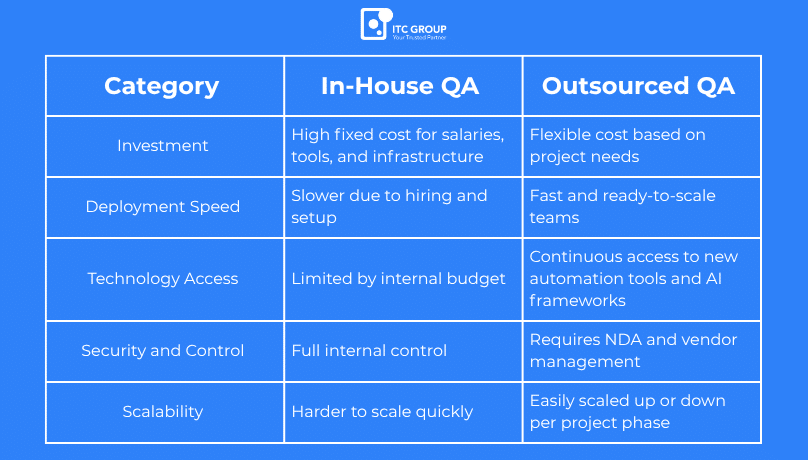









For modern enterprises, speed and reliability define success. As digital products evolve faster than ever, Quality Assurance has become a strategic pillar of sustainable software excellence — not just a back-office function.
Yet, despite advanced tools and agile methodologies, quality gaps persist. The World Quality Report 2024 reveals that more than 60% of product failures occur because defects go unnoticed before release. These issues drain resources, delay launches, and erode customer trust.
Leaders today face a crucial decision: should Quality Assurance remain an internal function that offers control and product familiarity, or should it be outsourced to experts who deliver scalability, innovation, and measurable efficiency?
Quality Assurance today is a strategic capability that defines whether products succeed in a market that expects speed and perfection. QA ensures that software functions as designed, delivers great user experiences, and maintains long-term reliability.
Modern QA is integrated into every phase of the software lifecycle. Agile and DevOps teams use continuous testing to identify and fix issues before they reach production. This integration prevents delays and improves confidence across engineering and management.
As outlined in Speed Up Your Releases with a Streamlined QA Framework, teams that embed QA into CI/CD pipelines deliver faster releases and dramatically reduce production defects. QA not only checks functionality but also strengthens collaboration between developers, testers, and product owners.
Effective QA brings measurable benefits:
According to Capgemini, organizations that treat Quality Assurance as a core business function achieve up to 30% fewer defects and 20% faster go-to-market times compared to companies that treat QA as a final step.
The role of Quality Assurance is evolving rapidly as AI and automation reshape testing and analysis. Instead of relying entirely on manual methods, companies now adopt intelligent systems that can predict, test, and learn continuously.
AI-driven testing tools analyze massive datasets, simulate user behavior, and generate test cases without manual input. These tools detect defects early and provide real-time performance insights.
Enterprises such as Microsoft and IBM now automate nearly 80% of repetitive QA processes, allowing specialists to focus on usability, performance, and strategic risk prevention.
As discussed in Overloaded Teams or Effective QA – Which Will You Choose?, automation enables QA teams to optimize workflows, deliver consistent results, and reduce manual strain across multiple releases.
“Modern Quality Assurance is not reactive. It anticipates problems, enabling faster innovation and reliable performance.”
AI and automation redefine QA as a proactive function that aligns technology and strategy, ensuring products are ready for the challenges of tomorrow’s digital ecosystem.
Choosing between in-house QA and outsourced Quality Assurance is a decision that affects cost, efficiency, and scalability. Each model brings distinct strengths depending on the project size, sensitivity, and timeline.

An internal QA team provides close control and deep product understanding. It suits industries like finance or healthcare, where compliance and data sensitivity are critical. However, in-house QA demands long-term investment in training, infrastructure, and retention.
Outsourced QA offers flexibility, cost optimization, and access to global expertise. Partnering with experienced vendors ensures access to the latest frameworks, tools, and testing environments.
As highlighted in Quality Control in Outsourcing: Where Standards Slip Unnoticed, working with trusted outsourcing partners enhances efficiency while maintaining strict quality standards.
“The most successful companies combine internal insight with external expertise to achieve higher testing coverage and faster delivery.”
At ITC Group, we tailor QA solutions to match each project’s scale and timeline, ensuring testing aligns seamlessly with the development lifecycle. Our model optimizes total cost of ownership through automation and resource efficiency while maintaining full visibility and control via transparent reporting. With deep technical expertise, ITC expands your QA capabilities and helps you deliver reliable, high-performing software at lower risk and higher speed.

Selecting the right Quality Assurance approach requires careful analysis of goals, budget, and operational needs. Business leaders should evaluate the following:
Long-term and complex projects often benefit from in-house Quality Assurance teams that understand business logic, architecture, and compliance. Their continuity reduces rework and improves test accuracy over time. Short-term or seasonal projects fit better with outsourced QA, which scales quickly and adapts to changing workloads without long-term hiring. A blended approach works best: keep strategic testing internal while using partners for specialized or high-volume needs to maintain balance between speed, cost, and quality.
In-house Quality Assurance involves fixed expenses such as recruitment, training, and tool maintenance, along with hidden costs like turnover and infrastructure updates. Outsourced QA converts those into flexible project-based fees, enabling predictable budgets and lower financial risk. Mature vendors also include automation frameworks and testing environments in their services, which prevents duplicated costs. Evaluating the cost per avoided defect or reduced downtime gives a clearer view of ROI and shows where outsourcing adds measurable business value.
An in-house Quality Assurance model offers direct oversight and faster coordination with developers and product teams, making it ideal for projects with frequent requirement changes or strict regulations. Outsourcing requires structured governance, clear KPIs, and transparent reporting to maintain alignment. Real control comes from visibility, not physical proximity, consistent dashboards, progress metrics, and review cycles ensure that quality stays measurable and predictable, regardless of where the team operates.
Internal Quality Assurance teams may lack access to modern automation frameworks, AI-driven testing, or large device labs, which slows regression and reduces coverage. External vendors bring advanced tools and specialized expertise, offering performance, security, and analytics testing that accelerate releases and raise product reliability. The right choice depends on your risk profile: if customer trust or compliance is critical, prioritize QA partners or internal teams that demonstrate proven mastery in those high-stakes areas.
Quality Assurance defines how customers perceive your brand. A well-structured QA process protects product integrity, strengthens trust, and supports innovation.
Outsourcing QA provides scalability, access to global talent, and cutting-edge technology. It helps companies deliver faster while maintaining high performance.
Businesses benefit from:
“Quality builds trust”. Investing in Quality Assurance through strategic outsourcing secures growth and resilience in a competitive world.”
ITC Group supports enterprises with end-to-end QA sourcing from consultation and planning to full implementation. Our experts provide continuous support and 24/7 guidance to ensure your QA ecosystem scales with your business objectives.
1. What is the purpose of Quality Assurance in software development?
It ensures software reliability, performance, and user satisfaction by identifying defects before deployment.
2. How does outsourcing reduce QA costs?
Outsourcing turns fixed expenses into flexible costs and minimizes recruitment, infrastructure, and training investments.
3. How secure is outsourced Quality Assurance?
Security depends on vendor standards. Certified QA providers follow ISO 27001 and GDPR compliance to safeguard data
4. What impact does AI have on Quality Assurance?
AI automates repetitive testing, predicts potential issues, and increases test precision, reducing manual workload significantly.
5. When should businesses consider hybrid QA?
A hybrid model is ideal when organizations want internal control for core testing while leveraging outsourced teams for scalability and speed.
Stay ahead in a rapidly changing world with our monthly look at the critical challenges confronting businesses on a global scale, sent straight to your inbox.